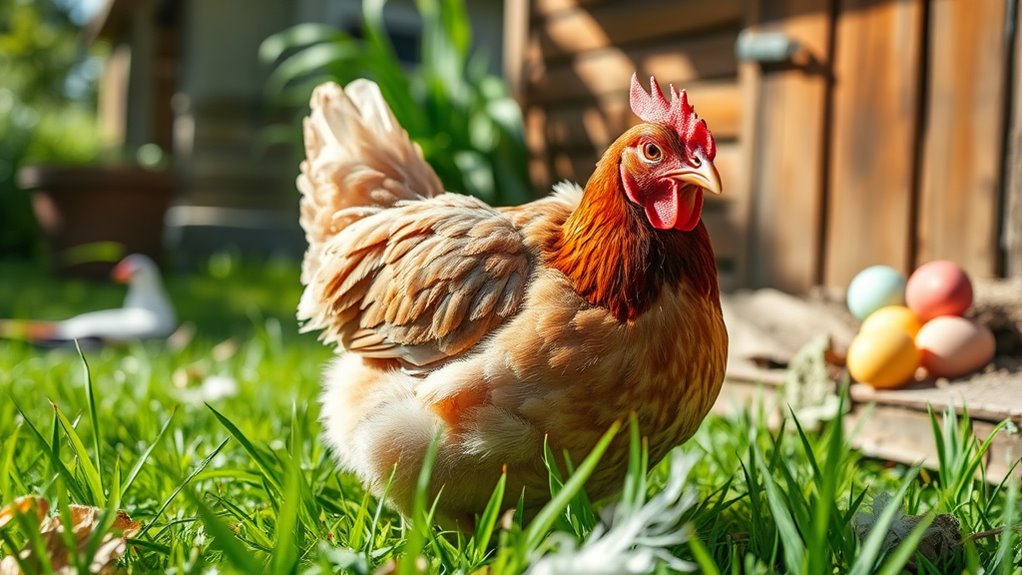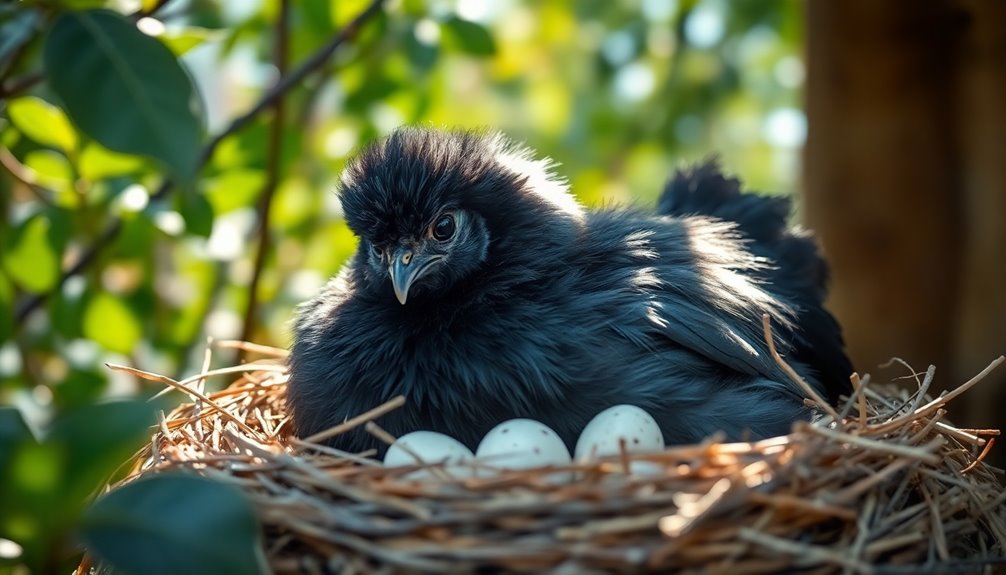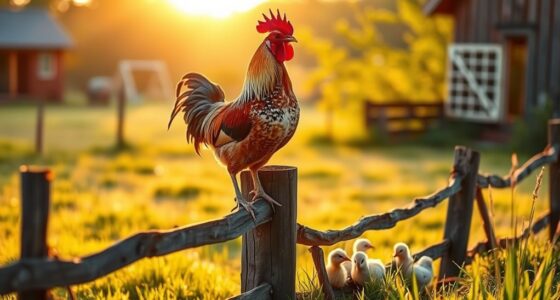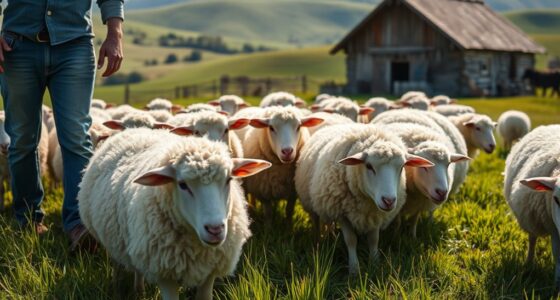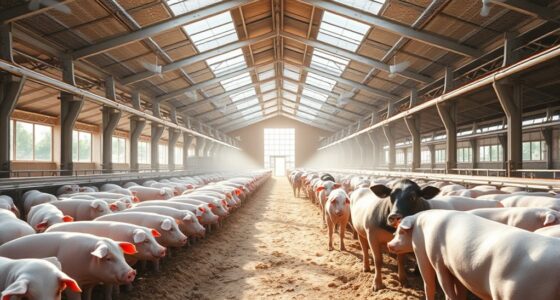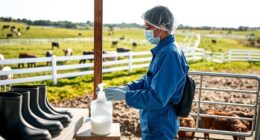To manage feather molt in your backyard chickens, watch for signs like dull, broken, or missing feathers, usually in late summer or fall. Support their recovery by providing a balanced, high-protein diet, fresh greens, and consistent feeding routines. Guarantee they have a comfortable environment with outdoor access, parasite control, and minimal stress. Keeping conditions ideal helps their feathers grow back strong. For more tips on a smooth molt, keep exploring the essential care strategies.
Key Takeaways
- Provide a balanced, high-protein diet with essential vitamins and minerals to support healthy feather growth during molt.
- Maintain a consistent feeding schedule and proper hydration to ensure steady nutrient intake throughout the molting process.
- Minimize stress by providing a calm environment, hiding spots, and outdoor access to promote overall health and reduce molting duration.
- Regularly check for parasites, keep the coop clean, and use dust baths to prevent external infestations that can hinder feather regeneration.
- Monitor for signs of illness or nutritional deficiencies, and seek veterinary advice promptly for persistent or severe health issues.
Recognizing Signs and Stages of Molt
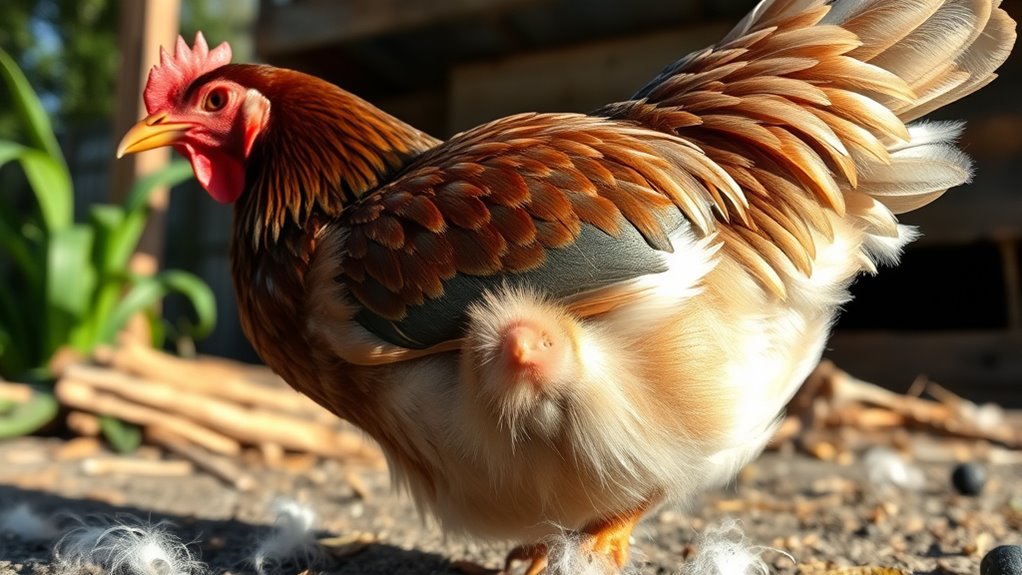
Understanding the signs and stages of molt is essential for managing your backyard chickens effectively. You’ll notice changes in feather quality, such as dull, broken, or missing feathers, signaling that molting is underway. Usually, chickens begin molting in late summer or fall, marking the molt timing. During this period, their feathers may look ragged or patchy, and they might become less active or lose appetite. Recognizing these early signs helps you prepare and prevent stress. The molt has distinct stages, from initial feather loss to new feather growth. By observing these cues, you can gauge how long it will last and plan accordingly. Staying attentive to feather quality and molt timing guarantees you can support your chickens throughout this natural process. Additionally, providing proper nutrition during molt can help ensure healthy feather regrowth and overall well-being. Understanding the genetic factors involved in feather molt can also assist in selecting resilient breeds that handle the process more smoothly. Knowing about molt duration helps you anticipate when your flock will fully recover and regain their full plumage. Recognizing the environmental conditions that influence molting can further aid in creating a supportive environment for your hens.
Providing a Nutritious Diet to Support Feather Growth
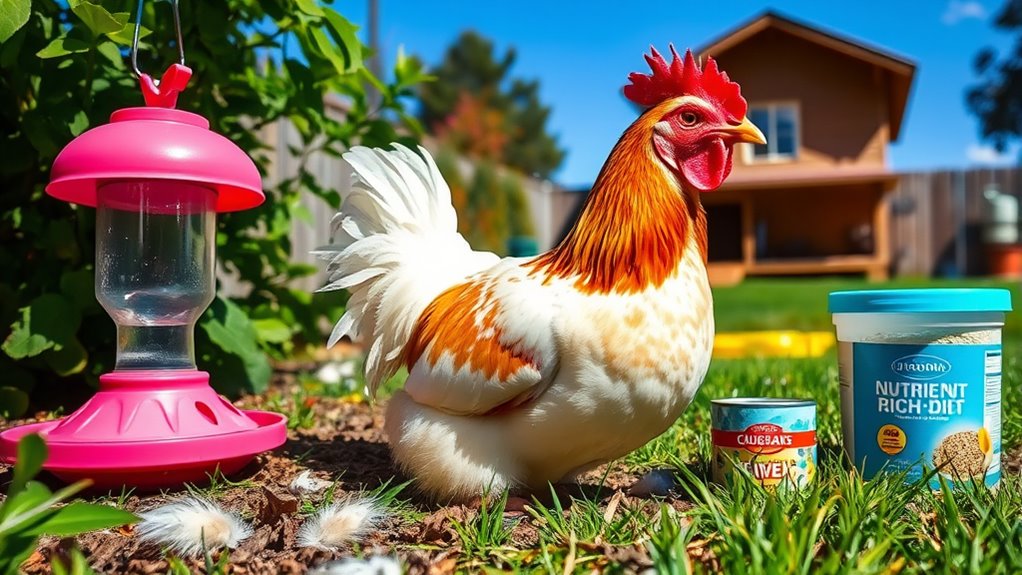
To support healthy feather growth, you need to provide your chickens with a balanced diet rich in protein, vitamins, and minerals. Incorporate quality sources like insects, fish meal, or commercial feeds designed for molting birds. Stick to a consistent feeding schedule to guarantee your chickens get the nutrients they require during this critical time. Ensuring proper nutrition management can significantly improve their recovery and feather regrowth process. Additionally, incorporating climate control strategies such as maintaining appropriate shelter temperatures can help reduce stress and promote overall health during molt. Being aware of forsale 100 options for supplements or feed additives can also aid in enhancing their nutritional intake during this period. Proper pimple patch usage techniques can also be employed to address skin irritations that sometimes occur during molting, ensuring your hens stay comfortable and healthy. Monitoring stress levels in your flock and minimizing disturbances can further support a smooth molting process.
Balanced Protein Sources
Providing your chickens with balanced protein sources is essential for supporting healthy feather growth during molt. Protein helps replace lost feathers and keeps your flock looking vibrant. When chickens lack adequate protein, you may notice an egg laying decline, which signals their bodies are diverting energy from production to recovery. Additionally, insufficient protein can lead to dull or faded feather color changes, reducing their overall appearance. High-quality sources like mealworms, fish meal, soy, and balanced commercial feeds supply the necessary amino acids to promote strong, new feathers. Guarantee your chickens receive enough protein daily, especially during molt, to accelerate recovery and maintain their health. Proper nutrition now will help your flock emerge from molt with shiny, resilient feathers. Ensuring proper nutrition is crucial for supporting overall health and feather regeneration during this period, and incorporating a variety of protein-rich foods can further optimize feather growth. Consistent access to nutrient-dense feed also ensures that your chickens are getting the essential vitamins and minerals required for optimal recovery.
Vitamins and Minerals
Vitamins and minerals play a crucial role in supporting feather growth during molt. They help prevent mineral deficiencies that can hinder feather development and overall health. To guarantee your chickens get enough, consider adding supplements for molting to their diet. Here are three key nutrients to focus on:
- Biotin and Vitamin A – promote healthy feather production and skin health.
- Calcium and Phosphorus – strengthen feather shafts and support cellular growth.
- Zinc and Selenium – aid in new feather formation and immune support. Regular Proper nutrition is essential for maintaining the health and resilience of your flock during this demanding period. Ensuring a balanced diet with these essential minerals and vitamins helps your chickens recover faster from molt. Additionally, providing adequate hydration supports overall health and feather regeneration.
Feeding Schedule Tips
Establishing a consistent feeding schedule is essential for supporting healthy feather growth during molt. Proper nutrition aids in recovery after feather shedding and aligns with molt timing. Feed your chickens at regular intervals to ensure they get steady nutrients. Focus on a balanced diet that includes protein, grains, and supplements. To visualize, consider this sample schedule:
| Time of Day | Meal Type | Purpose |
|---|---|---|
| Morning | High-protein feed | Boost feather regrowth |
| Midday | Fresh greens | Vitamins & minerals support |
| Evening | Grains & scraps | Energy for recovery |
Sticking to this routine keeps your flock well-nourished, especially during feather shedding, encouraging faster, healthier feather restoration. Proper nutrition plays a crucial role in supporting overall health and feather development during molt.
Ensuring Comfortable Living Conditions During Molt
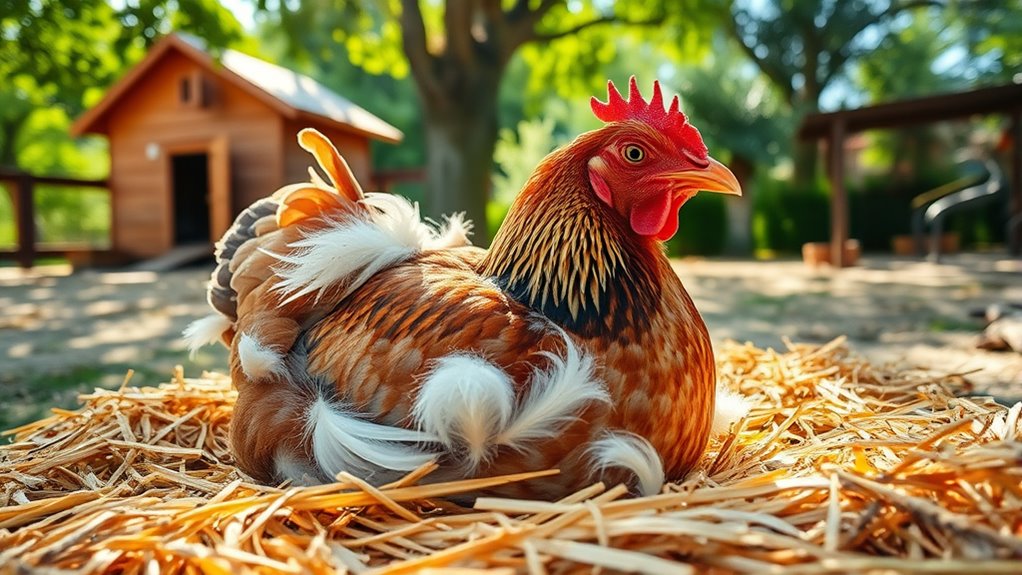
During molt, chickens can become stressed and uncomfortable, so creating a calm, safe environment is essential. To support them, focus on these key areas:
- Provide a quiet space with minimal disturbances to reduce stress and prevent broodiness management issues. Incorporating stress reduction techniques can further help in calming the flock during this vulnerable period. You can also consider environmental enrichment to keep them mentally stimulated and relaxed.
- Ensure proper lighting that doesn’t disrupt feather color and helps regulate their cycle. Maintaining consistent light patterns can also minimize stress.
- Maintain clean, dry bedding to promote comfort and prevent infections, especially during feather regrowth. Regular bedding changes help keep the environment sanitary and comfortable.
- Incorporate natural connection practices, such as allowing outdoor time, to help reduce stress and promote emotional well-being during molt. Facilitating outdoor access can improve their overall health and reduce boredom.
Managing Parasites and Preventing Illness
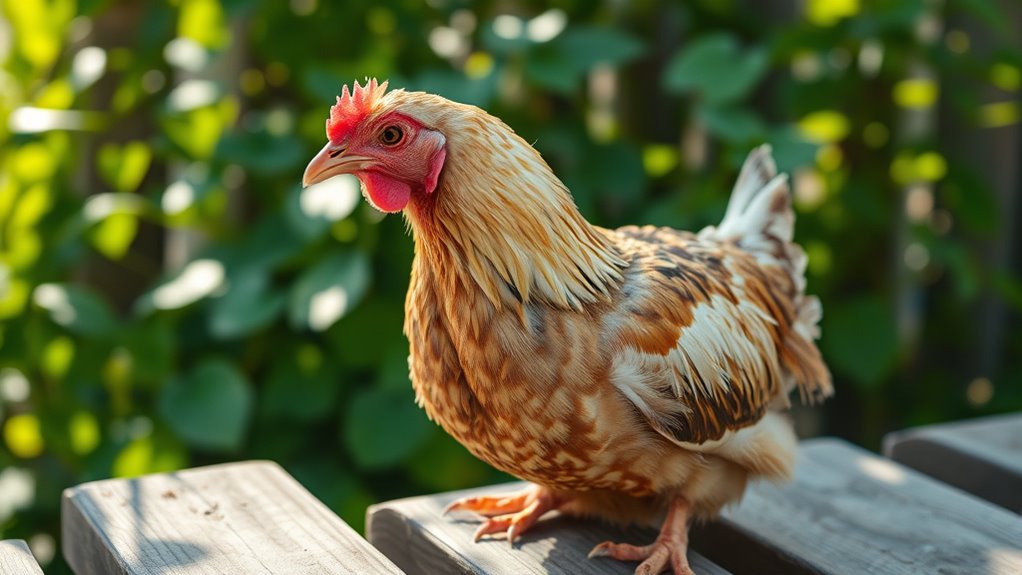
Keeping your chickens healthy requires regular parasite checks and a clean coop environment. You should also watch for signs of illness and address issues promptly. Staying proactive helps prevent problems and keeps your flock strong during molt. Incorporating preventive health measures can further reduce the risk of illness and support overall flock well-being. Regularly monitoring for cybersecurity threats is also essential when managing digital records of your flock to prevent data breaches. Additionally, understanding water management practices can contribute to a healthier environment for your chickens and reduce the risk of waterborne illnesses.
Regular Parasite Checks
Regular parasite checks are essential for maintaining your backyard chickens’ health and preventing illness. Parasites can cause discomfort, feather plucking, and poor feather quality. To keep them healthy, regularly inspect your chickens for signs of parasites, such as irritated skin or unusual feather loss. Here are three key steps:
- Check for external parasites like mites and lice, especially around the vent and under wings.
- Ensure your chickens have access to dust baths, which naturally help control mites and lice.
- Monitor for behavioral signs like excessive scratching or feather plucking, which might indicate parasite issues or stress.
Maintain Clean Coop Environment
A clean coop is essential for preventing parasites and protecting your chickens from illness. Regular coop cleaning removes droppings, old bedding, and debris that attract parasites like mites and lice. Focus on thorough cleaning of all surfaces, including nest boxes and perches. Vent sanitation is equally important; ensure the ventilation system remains clear of dust and moisture to promote good air flow. Proper ventilation reduces humidity, discouraging mold and bacteria growth that can lead to respiratory issues. By maintaining a tidy environment, you minimize the risk of disease transmission and create a healthier space for your flock. Consistent cleaning routines and attention to vent sanitation are key steps to keeping your chickens healthy and reducing feather molt disruptions caused by illness.
Monitor Bird Health
Monitoring your flock’s health is essential for early detection and swift treatment of parasites and illnesses that can interfere with feather molt. Keep an eye on signs like feather color changes, which may indicate nutritional deficiencies or health issues. Regular checks allow you to identify problems before they worsen. To stay proactive, consider these steps:
- Inspect birds daily for parasites such as mites or lice, which can cause discomfort and disrupt molt.
- Observe egg production; a sudden drop may signal illness or stress.
- Watch for lethargy or abnormal behavior, which can be early signs of disease affecting feather regrowth.
Handling Behavioral Changes and Stress
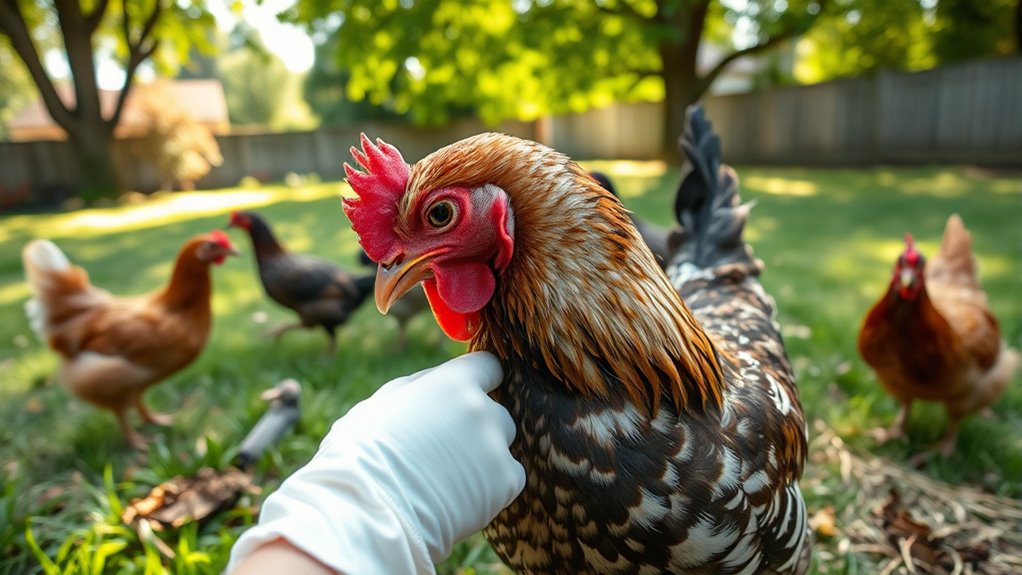
When your chickens go through a molt, their behavior often shifts as they experience stress and discomfort. You might notice behavioral signs like withdrawal, decreased activity, or reduced eating. They may become more irritable or aggressive, especially if you try to handle them. To manage stress effectively, keep their environment calm and consistent, avoiding sudden changes. Provide plenty of comfortable hiding spots and ensure they have access to nutritious feed and fresh water. Minimize handling during this period to reduce additional stress. Observing these behavioral signs helps you identify when your chickens are stressed. Practicing stress management techniques, such as limiting loud noises and maintaining a peaceful coop, can help your birds recover more comfortably from their molt.
When to Seek Veterinary Assistance
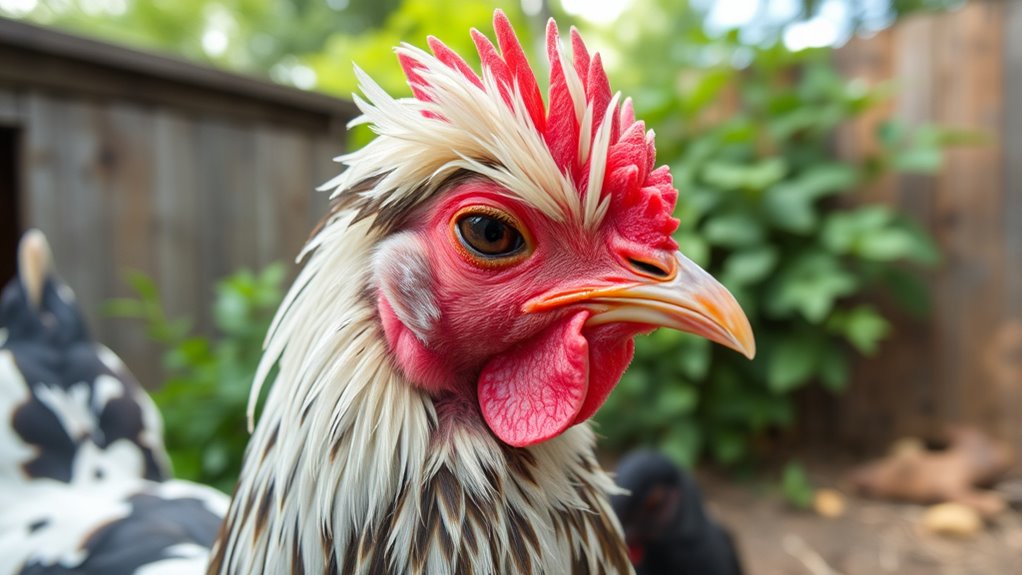
Recognizing signs that indicate the need for veterinary help is essential during a molt, especially if your chickens show persistent or worsening symptoms. Hormonal shifts and seasonal variations can influence feather loss, but certain issues require professional attention. You should seek veterinary assistance if:
- Your chicken’s feather loss is excessive or uneven, indicating possible underlying health problems.
- There are signs of infection, such as swelling, discharge, or foul odor around the skin.
- Your chicken shows lethargy, loss of appetite, or other signs of illness that don’t improve with basic care.
Persistent symptoms may signal a parasite infestation, nutritional deficiency, or other health concerns. Timely veterinary help guarantees your chickens stay healthy through seasonal changes and hormonal shifts affecting their molt.
Frequently Asked Questions
How Long Does Feather Molt Typically Last in Backyard Chickens?
Feather molt in backyard chickens typically lasts about 6 to 8 weeks, but the molt timeline can vary based on age, health, and breed. During this period, your chickens focus on feather repair, shedding old feathers and growing new ones. You might notice some patchiness or dull feathers, but patience helps. Make sure they get good nutrition and minimal stress to support a smooth molt process and quicker recovery.
Can I Speed up the Molt Process Naturally?
Sure, you can try speeding up a chicken’s molt—because who wouldn’t want a quick, hairless transformation? Ironically, natural remedies and dietary supplements are your best bets. Offer extra protein and vitamins, like fish meal or crushed eggshells, to support feather growth. While it won’t turn a slow molt into a sprint, it helps your hen recover faster and look fabulous again, feathered and all.
Are There Specific Breeds More Prone to Prolonged Molting?
Certain breeds are more prone to prolonged molting because of breed susceptibility and seasonal patterns. You’ll notice that dual-purpose or heritage breeds often take longer to complete their molt, especially during colder months when seasonal patterns influence feather regrowth. Keep an eye on your chickens’ breed type, as some naturally molt slower. Providing proper nutrition and stress reduction can help all breeds through a healthier, less prolonged molt.
How Can I Tell if a Chicken’S Feather Loss Is Due to Illness?
Think of spotting illness in your chicken like catching a hidden shadow. If your bird’s feather loss isn’t just due to natural molt, look for signs like dull feathers, lethargy, or abnormal feather regrowth. If you notice feather picking or uneven feather loss, it could signal illness. Keep an eye on behavior changes and consult a vet if you suspect health issues, ensuring your chicken recovers and regrows feathers healthily.
What Are Common Mistakes to Avoid During Molt Management?
During molt management, you should avoid common mistakes like neglecting proper nutrition and making improper handling practices. Don’t assume all chickens need the same diet; provide balanced nutrition rich in protein to support feather regrowth. Be gentle when handling your birds to reduce stress, which can hinder the molt process. Overlooking these aspects can slow recovery, so stay attentive and avoid rushing or rough handling during this critical time.
Conclusion
By understanding and supporting your backyard chickens through their molt, you become their hero, guiding them smoothly through this tough time. With patience, proper care, and attention, you’ll help them bounce back healthier and more vibrant than ever—like a phoenix rising from the ashes. Remember, your dedication can turn a stressful molt into a moment of growth and renewal for your flock. Stay vigilant, compassionate, and your chickens will thank you with their joyful feathers and lively spirit.

